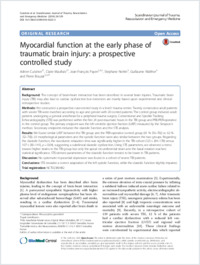Myocardial function at the early phase of traumatic brain injury: a prospective controlled study
- Cuisinier, Adrien Hospitalier Universitaire de Grenoble, France.
- Maufrais, Claire Laboratory of Integrative Cardiovascular and Metabolic Physiology, Divisionof Physiology, Department of Medicine, University of Fribourg, Switzerland
- Payen, Jean-François Hospitalier Universitaire de Grenoble, France. - Grenoble Institut des Neurosciences, France - Grenoble Alpes Université, Grenoble, France
- Nottin, Stephane Avignon University, France.
- Walther, Guillaume Avignon University, France.
- Bouzat, Pierre Hospitalier Universitaire de Grenoble, France. - Grenoble Institut des Neurosciences, France - Grenoble Alpes Université, Grenoble, France
-
2016
Published in:
- Scandinavian Journal of Trauma, Resuscitation and Emergency Medicine. - 2016, vol. 24, p. 129
English
The concept of brain-heart interaction has been described in several brain injuries. Traumatic brain injury (TBI) may also lead to cardiac dysfunction but evidences are mainly based upon experimental and clinical retrospective studies. Methods We conducted a prospective case-control study in a level I trauma center. Twenty consecutive adult patients with severe TBI were matched according to age and gender with 20 control patients. The control group included adult patients undergoing a general anesthesia for a peripheral trauma surgery. Conventional and Speckle Tracking Echocardiography (STE) was performed within the first 24 post- traumatic hours in the TBI group and PRE/PER-operative in the control group. The primary endpoint was the left ventricle ejection fraction (LVEF) measured by the Simpson’s method. Secondary endpoints included the diastolic function and the STE analysis. Results We found similar LVEF between the TBI group and the PER-operative control group (61 % [56–76]) vs. 62 % [52–70]). LV morphological parameters and the systolic function were also similar between the two groups. Regarding the diastolic function, the isovolumic relaxation time was significantly higher in the TBI cohort (125 s [84–178] versus 107 s [83–141], p = 0.04), suggesting a subclinical diastolic dysfunction. Using STE parameters, we observed a trend toward higher strains in the TBI group but only the apical circumferential strain and the basal rotation reached statistical significance. STE-derived parameters of the diastolic function tended to be lower in TBI patients. Discussion No systematic myocardial depression was found in a cohort of severe TBI patients. Conclusions STE revealed a correct adaptation of the left systolic function, while the diastolic function slightly
- Faculty
- Faculté des sciences et de médecine
- Department
- Département de Médecine
- Language
-
- English
- Classification
- Biological sciences
- License
- License undefined
- Identifiers
-
- RERO DOC 278637
- DOI 10.1186/s13049-016-0323-3
- Persistent URL
- https://folia.unifr.ch/unifr/documents/305455
Statistics
Document views: 72
File downloads:
- mau_mfe.pdf: 145
